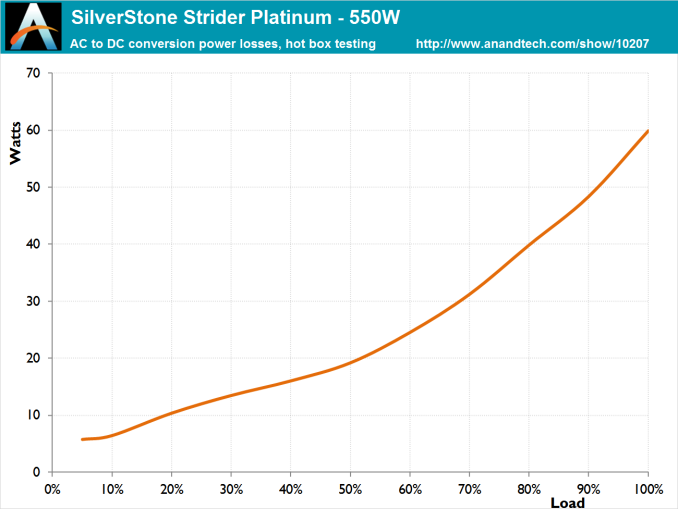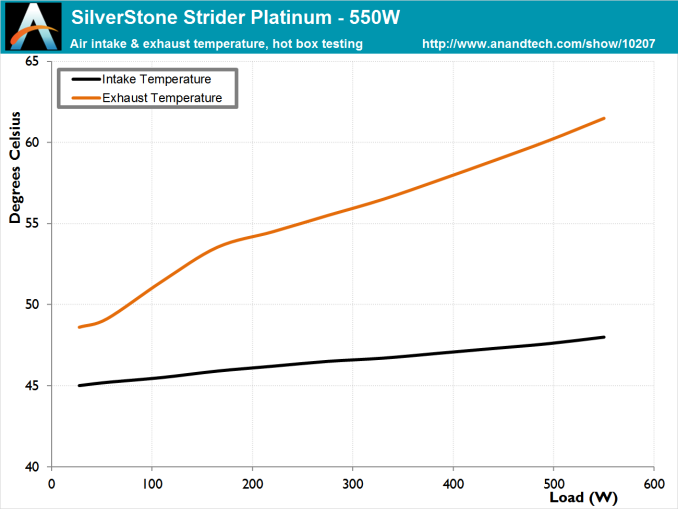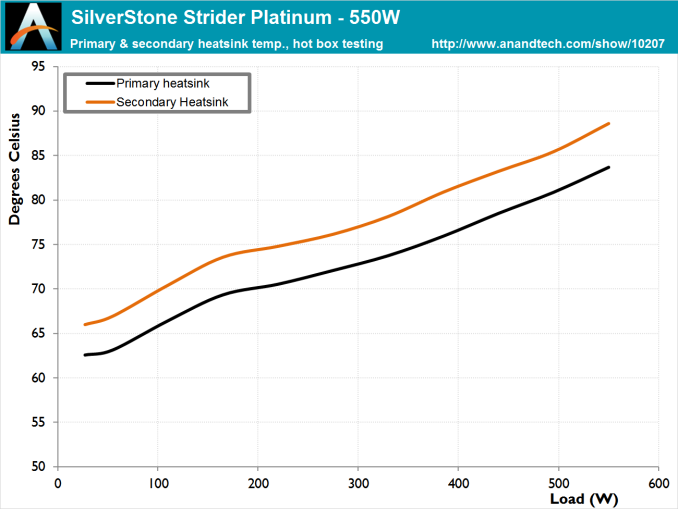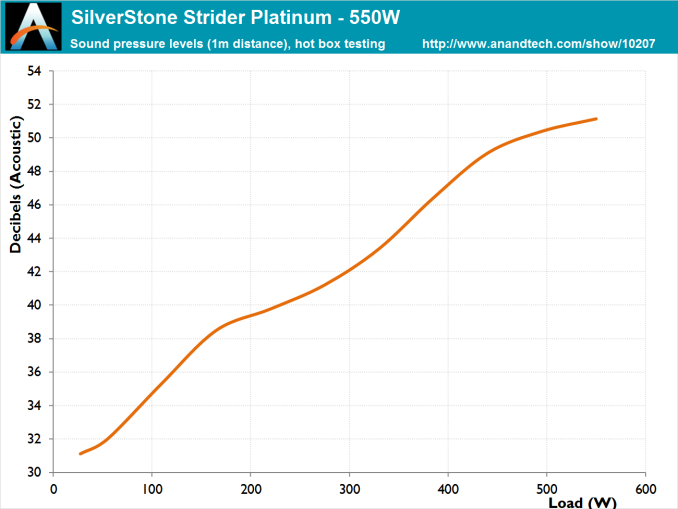The SilverStone Strider Platinum 550W PSU Review
by E. Fylladitakis on April 8, 2016 8:00 AM EST- Posted in
- PSUs
- Cases/Cooling/PSUs
- 550W
- SilverStone
- 80Plus Platinum
Hot Test Results
Looking at a detailed breakdown of performance under higher temperatures, the SilverStone Strider Platinum delivers mediocre electrical performance under stress for a PSU of its class. Our instrumentation recorded a maximum ripple of 60 mV on the 12V line, which is half of the 120 mV design limit, yet not really good for a premium PSU. Similarly, the voltage ripple on the 3.3V and 5V lines is 20mV and 26mV respectively. The voltage regulation leaves much to be desired as well, since we recorded excellent regulation of just 1.8% for the 12V line, but higher than 3.2% for the 3.3V/5V lines. These figures are uninspiring for a premium PSU design and surpass even the advertised 3% regulation.
| Main Output | ||||||||
| Load (Watts) | 111.94 W | 278.08 W | 413.92 W | 548.1 W | ||||
| Load (Percent) | 20.35% | 50.56% | 75.26% | 99.65% | ||||
| Amperes | Volts | Amperes | Volts | Amperes | Volts | Amperes | Volts | |
| 3.3 V | 1.74 | 3.43 | 4.34 | 3.4 | 6.51 | 3.36 | 8.68 | 3.31 |
| 5 V | 1.74 | 5.16 | 4.34 | 5.09 | 6.51 | 5.07 | 8.68 | 5 |
| 12 V | 7.97 | 12.17 | 19.92 | 12.11 | 29.87 | 12.02 | 39.83 | 11.95 |
| Line | Regulation (20% to 100% load) |
Voltage Ripple (mV) | |||||
| 20% Load | 50% Load | 75% Load | 100% Load | CL1 12V |
CL2 3.3V + 5V |
||
| 3.3V | 3.5% | 10 | 16 | 18 | 20 | 12 | 22 |
| 5V | 3.2% | 12 | 18 | 20 | 26 | 14 | 26 |
| 12V | 1.8% | 26 | 30 | 46 | 60 | 68 | 36 |
Even though this PSU is rated at 40 °C, we had no problem reaching it with a significantly higher ambient temperature. The impact on the conversion efficiency was minimal, with average nominal load (20-100%) efficiency dropping by only 1%, with a balanced drop across the entire load range and only slightly greater at maximum load, indicating that the components are not being overly stressed. The maximum efficiency now is 93% at 50% load, dropping down to a minimum of 89% at maximum load.
The semi fanless design of the Strider Platinum did not like the high ambient temperature inside our hotbox at all, forcing the fan to start nearly instantly after the PSU has been powered on. In order to combat the high ambient temperatures and, consequently, the high internal temperatures of the unit, the fan’s speed increases significantly alongside with the load, reaching nearly its maximum speed at 100% capacity. With a load greater than 200 Watts under such adverse conditions, the Strider Platinum would be clearly audible by the system’s user if a room reached these conditions. Nevertheless, the internal temperatures of the PSU do not get overly high, with the heatsinks staying below 90 °C under maximum load.















27 Comments
View All Comments
ImSpartacus - Friday, April 8, 2016 - link
Always awesome to see a psu review for a psu that I might actually consider.I also like the commentary about the rarity of low wattage platinum power supplies. I hasn't thought about it from that perspective.
close - Friday, April 8, 2016 - link
I guess people with "low power" systems rarely want to invest the extra money in better efficiency at that price level. This bring diminishing returns the smaller the PSU wattage is meaning you pay the same "extra" for the efficiency but get smaller benefits than you would on a 700+W PSU.close - Friday, April 8, 2016 - link
*on the first line it should read "at that power level", not price.ImSpartacus - Friday, April 8, 2016 - link
Yeah, I can definitely understand why that's the case. It's a reasonable perspective.Though, I don't know if I'd consider a 500W pc to be "low wattage." That's realistically all most single gpu gaming rigs ever need.
Murloc - Saturday, April 9, 2016 - link
low wattage as in the difference in efficiency is negligible from a power bill point of view, or actually a minus if you consider higher cost.Daniel Egger - Saturday, April 9, 2016 - link
Where I live you're typically pay 2€ per year per Watt consumed 27/4 (tendency rising). That can add up very quickly; my first home server used a total of 115W sustained, the successor was down to 65W, the next successor was down to 54W initially and then further tweaked down to 40W. That's a hell lot of money saved per year...close - Monday, April 11, 2016 - link
That's exactly what I meant by low wattage. When you have a sub-500W system the savings in economy are rarely recovered via increased efficiency. You need a higher difference from efficiency and to run the system 24/7 to get real benefits. Otherwise you just move the costs from really small installments every month for a few years into a bigger chunk payed at the purchase of the PSU.Namisecond - Monday, April 11, 2016 - link
Actually, you need to look at the efficiency curve. Most power supplies hit their highest efficiency at between 40-75% utilization. Unless you've got a monster gaming rig with dual or more SLI/Crossfire GPUs, you're not going to be in that zone with a 1200-1500W PSU.A single moderate (GTX970/980) GPU system with a quad core processor will probably hit about 300-350W while gaming. About where you want to be with a 500-600W PSU.
random2 - Wednesday, April 20, 2016 - link
Wattage aint everything. Many cheaper PSUs don't have the amps on the 12 volt rail necessary to push major GPUs.random2 - Wednesday, April 20, 2016 - link
Not to mention the 46 amps on the 12v rail. :)